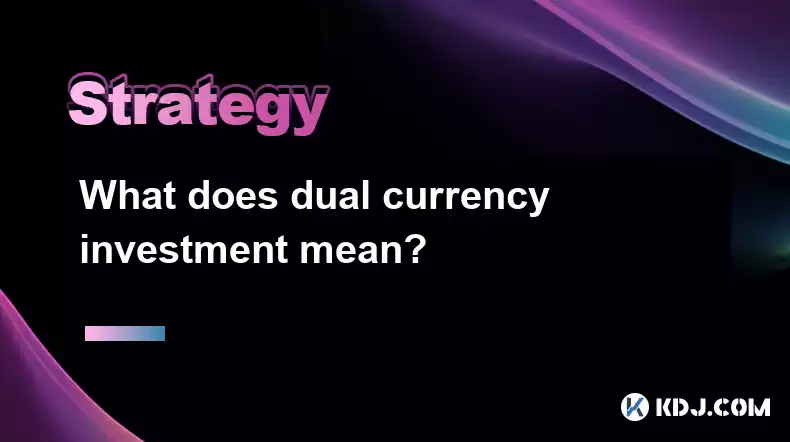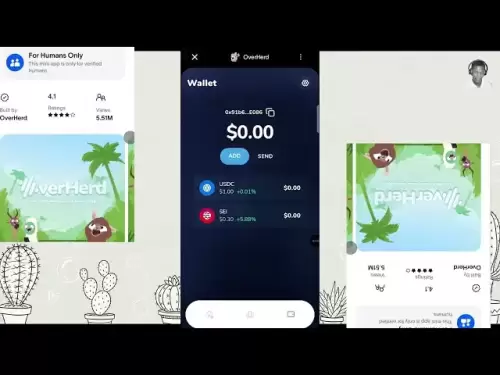-
 Bitcoin
Bitcoin $114100
-0.14% -
 Ethereum
Ethereum $3635
-0.73% -
 XRP
XRP $2.949
-2.85% -
 Tether USDt
Tether USDt $0.9999
-0.03% -
 BNB
BNB $760.3
-0.78% -
 Solana
Solana $163.8
-2.77% -
 USDC
USDC $0.9998
-0.04% -
 TRON
TRON $0.3323
-0.57% -
 Dogecoin
Dogecoin $0.2004
-2.99% -
 Cardano
Cardano $0.7245
-2.87% -
 Hyperliquid
Hyperliquid $37.52
-3.75% -
 Stellar
Stellar $0.3915
-3.58% -
 Sui
Sui $3.416
-2.20% -
 Bitcoin Cash
Bitcoin Cash $559.5
-0.84% -
 Chainlink
Chainlink $16.41
-2.16% -
 Hedera
Hedera $0.2406
-1.78% -
 Ethena USDe
Ethena USDe $1.001
0.00% -
 Avalanche
Avalanche $22.13
-1.98% -
 Litecoin
Litecoin $117.8
-4.32% -
 UNUS SED LEO
UNUS SED LEO $8.989
0.01% -
 Toncoin
Toncoin $3.183
-5.09% -
 Shiba Inu
Shiba Inu $0.00001214
-1.97% -
 Uniswap
Uniswap $9.654
-1.71% -
 Polkadot
Polkadot $3.616
-1.18% -
 Monero
Monero $291.6
-2.66% -
 Dai
Dai $0.9999
0.00% -
 Bitget Token
Bitget Token $4.310
-1.10% -
 Cronos
Cronos $0.1382
-1.93% -
 Pepe
Pepe $0.00001021
-3.40% -
 Aave
Aave $257.9
-1.42%
What does dual currency investment mean?
Dual currency investment entails holding two different currencies to profit from exchange rate fluctuations, offering diversification and potential returns.
Jan 08, 2025 at 10:11 am

Key Points:
- Definition of dual currency investment
- Benefits of dual currency investment
- Risks of dual currency investment
- How to invest in dual currencies
- Case study: Example of dual currency investment
Article:
What is Dual Currency Investment?
Dual currency investment is an investment strategy that involves holding two different currencies. The goal is to profit from exchange rate fluctuations between the two currencies. For instance, if you invest in the US dollar and the euro, and the euro strengthens against the dollar, you will make a profit on your euro investment.
There are two main types of dual currency investments:
- Hedged: A hedged dual currency investment involves buying one currency forward while selling the other spot (immediately). This protects the investor from exchange rate fluctuations.
- Unhedged: An unhedged dual currency investment involves buying and selling both currencies spot. This leaves the investor exposed to exchange rate fluctuations.
Benefits of Dual Currency Investment:
- Diversification: Investing in dual currencies diversifies your portfolio by reducing your exposure to a single currency.
- Potential for return: If the exchange rate fluctuations between the two currencies are favorable, you can earn a profit.
- Hedge against inflation: Dual currency investment can act as a hedge against inflation in either or both currencies.
Risks of Dual Currency Investment:
- Exchange rate risk: The primary risk associated with dual currency investment is exchange rate risk. If the exchange rate moves against you, you can lose money.
- Currency controls: Some countries impose currency controls, which restrict the movement of money into and out of the country. This can make it difficult to invest in dual currencies.
- Liquidity risk: Dual currency investments may not be as liquid as investments in single currencies, especially in emerging markets.
How to Invest in Dual Currency:
Several ways to invest in dual currencies include:
- Forex trading: You can speculate on exchange rate fluctuations through retail forex brokers.
- Currency ETF: You can invest in ETFs that track the performance of two currencies.
- Dual currency bonds: You can invest in bonds that pay interest in two different currencies.
Case Study: Example of Dual Currency Investment
- An investor purchases $100,000 worth of euros.
- Over the next year, the euro strengthens against the dollar by 10%.
- The investor now has €90,909.09 ($110,000).
- The investor earned a profit of $10,000 (10%).
FAQs:
1. What are the best currency pairs for dual currency investment?
There is no definitive answer to this question. The best currency pairs depend on market conditions and your investment goals. However, some popular currency pairs for dual currency investment include EUR/USD, USD/JPY, and GBP/USD.
2. What is the minimum investment amount for dual currency investment?
The minimum investment amount for dual currency investment varies depending on the platform or broker you use. Some brokers offer low minimums, such as $1,000, while others have higher minimums.
3. How long should you hold a dual currency investment?
The holding period for a dual currency investment depends on your investment goals and risk tolerance. If you are looking for a short-term profit, you may hold your investment for a few months. If you are looking for a long-term profit, you may hold your investment for several years or even decades.
4. What are the tax implications of dual currency investment?
The tax implications of dual currency investment vary depending on your country of residence. In the United States, you will need to report any profits or losses from dual currency investment on your tax return.
5. Can you lose money in dual currency investment?
Yes, you can lose money in dual currency investment. If the exchange rate moves against you, you may lose some or all of your investment.
Disclaimer:info@kdj.com
The information provided is not trading advice. kdj.com does not assume any responsibility for any investments made based on the information provided in this article. Cryptocurrencies are highly volatile and it is highly recommended that you invest with caution after thorough research!
If you believe that the content used on this website infringes your copyright, please contact us immediately (info@kdj.com) and we will delete it promptly.
- Coinbase, Financing, and the Crypto Market: Navigating Choppy Waters in NYC Style
- 2025-08-06 12:50:11
- Bitcoin in Indonesia: Crypto Education and Economic Strategy
- 2025-08-06 12:50:11
- DeriW Mainnet: Zero Gas Fees Revolutionize On-Chain Derivatives Trading
- 2025-08-06 10:30:11
- IOTA, Cloud Mining, and Eco-Friendly Crypto: A New York Investor's Take
- 2025-08-06 10:30:11
- Kaspa (KAS) Price Prediction: August 6 - Will It Break Free?
- 2025-08-06 10:50:12
- Pension Funds, Bitcoin ETFs, and Exposure: A New Era of Institutional Crypto Adoption
- 2025-08-06 12:55:12
Related knowledge

How to avoid common crypto investment mistakes?
Jul 13,2025 at 01:35am
Understanding the Risks of Crypto InvestmentInvesting in cryptocurrency can be highly rewarding, but it also comes with significant risks. One of the ...

What is a long-short crypto strategy?
Jul 15,2025 at 10:56am
Understanding the Basics of a Long-Short Crypto StrategyA long-short crypto strategy is an investment approach where traders simultaneously take long ...

What is a long-short crypto strategy?
Jul 11,2025 at 01:28pm
Understanding the Basics of Long-Short Crypto StrategyA long-short crypto strategy is an investment approach where traders take both long and short po...

How to use the RSI indicator for crypto?
Jul 12,2025 at 03:56pm
Understanding the RSI Indicator in Cryptocurrency TradingThe Relative Strength Index (RSI) is a momentum oscillator used to measure the speed and chan...

Is copy trading a good strategy for crypto beginners?
Jul 12,2025 at 08:28am
Understanding Copy Trading in the Cryptocurrency MarketCopy trading is a strategy where novice traders replicate the trades of experienced investors a...

How to build a crypto portfolio with $1000?
Jul 13,2025 at 08:14pm
Understanding the Basics of Cryptocurrency InvestmentBuilding a crypto portfolio with $1000 starts with understanding the fundamentals of cryptocurren...

How to avoid common crypto investment mistakes?
Jul 13,2025 at 01:35am
Understanding the Risks of Crypto InvestmentInvesting in cryptocurrency can be highly rewarding, but it also comes with significant risks. One of the ...

What is a long-short crypto strategy?
Jul 15,2025 at 10:56am
Understanding the Basics of a Long-Short Crypto StrategyA long-short crypto strategy is an investment approach where traders simultaneously take long ...

What is a long-short crypto strategy?
Jul 11,2025 at 01:28pm
Understanding the Basics of Long-Short Crypto StrategyA long-short crypto strategy is an investment approach where traders take both long and short po...

How to use the RSI indicator for crypto?
Jul 12,2025 at 03:56pm
Understanding the RSI Indicator in Cryptocurrency TradingThe Relative Strength Index (RSI) is a momentum oscillator used to measure the speed and chan...

Is copy trading a good strategy for crypto beginners?
Jul 12,2025 at 08:28am
Understanding Copy Trading in the Cryptocurrency MarketCopy trading is a strategy where novice traders replicate the trades of experienced investors a...

How to build a crypto portfolio with $1000?
Jul 13,2025 at 08:14pm
Understanding the Basics of Cryptocurrency InvestmentBuilding a crypto portfolio with $1000 starts with understanding the fundamentals of cryptocurren...
See all articles

























































































